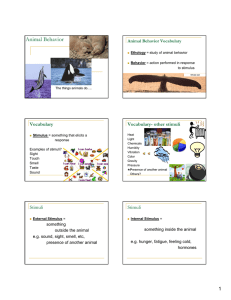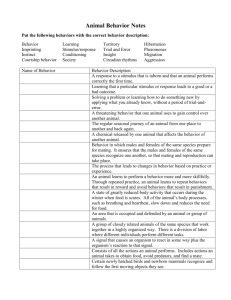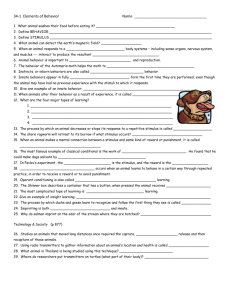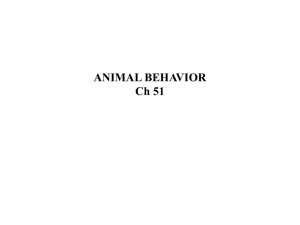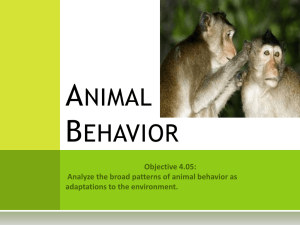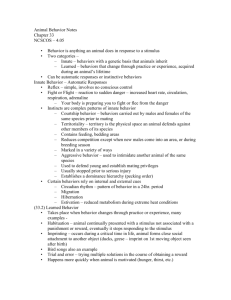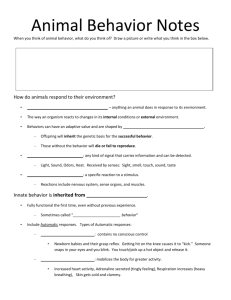Vocabulary Ethology = study of animal behavior
advertisement
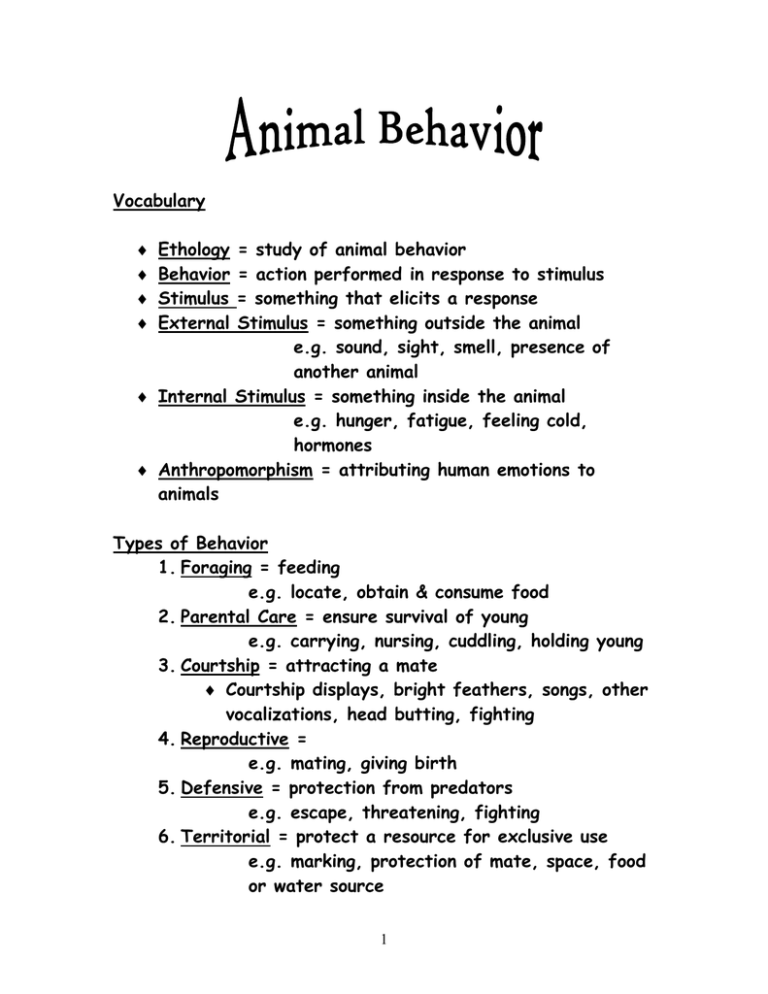
Vocabulary = study of animal behavior = action performed in response to stimulus = something that elicits a response Stimulus = something outside the animal e.g. sound, sight, smell, presence of another animal Internal Stimulus = something inside the animal e.g. hunger, fatigue, feeling cold, hormones Anthropomorphism = attributing human emotions to animals Ethology Behavior Stimulus External Types of Behavior 1. Foraging = feeding e.g. locate, obtain & consume food 2. Parental Care = ensure survival of young e.g. carrying, nursing, cuddling, holding young 3. Courtship = attracting a mate Courtship displays, bright feathers, songs, other vocalizations, head butting, fighting 4. Reproductive = e.g. mating, giving birth 5. Defensive = protection from predators e.g. escape, threatening, fighting 6. Territorial = protect a resource for exclusive use e.g. marking, protection of mate, space, food or water source 1 7. Social = work to create alliances, help the group e.g., babysitting, defense of musk ox young, play, play fight 8. Migratory = movement to a more suitable environment as seasons change e.g. dry vs. rainy seasons, winter vs. summer range for browsers and birds e.g. salmon upriver to spawn, artic tern – 1800 meters from Arctic to Antarctic 9. Communication = signaling between one animal and another Greeting e.g. sniff, hug, kiss “bite” Aggression e. g. charge, bite, hit, fight, etc. Non-aggression e.g. patting, head butting, stroking Grooming (bonding, alliances, keeping clean) Group hunt ( e.g.hyenas, lions) Vocalizations e.g. bark, growl, snort, howl, hoot, chirp, whinny, alarm sound Non-verbal signaling e.g. body, head, ear, & / or tail position showing teeth, smiling, looking away, looking directly at, gesturing, thumping, beating chest, raising hackles or hood, drumming, tail slap, snort, scenting, pheromones 10. Curiosity = investigating new stimulus in environment e.g. approach, sniff, chew, bite, mount, 11. Elimination = defecation, urination 12. Resting = apparent inaction e.g. lying down, sitting, basking, sleeping, loafing 2 Evolution of Behavior (i.e. Why or how do behaviors develop?) Types of Behavior Development: 1. Natural Selection An animal that successfully completes a helpful behavior survives to pass on the behavior to offspring E.g. lion infanticide (new alpha male kills all former alpha’s get) Why would this be beneficial to the species? 2. Innate Behavior Appear in fully functional form when first performed E.g. Startle behavior – purpose = selfpreservation E.g. web building, suckling, bird begging, nest building, some bird song 3. Learning development of behaviors through experience determines final shape of innate behaviors 4 types of learning Many Behaviors have both an innate and learned components e.g. Imprinting = learning can occur only during period changed once learned early in life & can’t be changed once learned (see Conrad Lorenz with ducklings) 3 Types of Learming 1. Habituation Animal learns to ignore frequent, harmless stimulus E.g. scarecrow, habituation to observer 2. Classical Conditioning Animal learns to associate unrelated response with a stimulus E.g. Pavlov’s experiments (see pix) 1. bell ringing, food, salivation 2. bell ringing, salivation (even if no food is given) E.g. 1. leash = going for a walk, excitement 2. sight of leash = excitement 3. Operant Conditioning Animal learns to behave in a certain way through repeated practice Trial & error learning – animal tests conditions for desired response e.g. Skinner box Animal learns that a behavior gets a certain response e.g. rat presses lever, gets food Positive Reinforcement - response good, behavior continues Negative Reinforcement – response bad, behavior is punished, may discontinue 4. Reasoning Analyze problem & devise solution using past experiences Dogs? No, can’t unwind leash from tree 4 Primates? yes e.g. chimp, bananas, boxes e.g. Japanese macaques float grain in water Communication = interaction between animals Modes of Communication 1. Visual 2. Sound 3. Chemicals / Pheromones (any chemical signal that causes change in behavior) 4. Body Posture / facial expression 5. Language? Signs, gestures Why does Communication occur? 1. Defense (warn away) 2. Alliance (get helper or mate) 3. Elicit play (see Jack Hanna video with Alex the Parrot) 5 Vocabulary Ethology = study of animal behavior 6 Behavior = action performed in response to stimulus Stimulus = something that elicits a response External Stimulus = something outside the animal e.g. sound, sight, smell, presence of another animal Internal Stimulus = something inside the animal e.g. hunger, fatigue, feeling cold, hormones Anthropomorphism = attributing human emotions to animals Types of Behavior 1. Foraging = feeding e.g. locate, obtain & consume food 2. Parental Care = ensure survival of young e.g. carrying, nursing, cuddling, holding young 3. Courtship = attracting a mate Courtship displays, bright feathers, songs, other vocalizations, head butting, fighting 4. Reproductive = e.g. mating, giving birth 5. Defensive = protection from predators e.g. escape, threatening, fighting 6. Territorial = protect a resource for exclusive use e.g. marking, protection of mate, space, food or water source 7. Social = work to create alliances, help the group e.g., babysitting, defense of musk ox young, play, play fight 8. Migratory = movement to a more suitable environment as seasons change 7 e.g. dry vs. rainy seasons, winter vs. summer range for browsers and birds e.g. salmon upriver to spawn, artic tern – 1800 meters from Arctic to Antarctic 9. Communication = signaling between one animal and another Greeting e.g. sniff, hug, kiss “bite” Aggression e. g. charge, bite, hit, fight, etc. Non-aggression e.g. patting, feline head butting, stroking Grooming (bonding, alliances, keeping clean) Group hunt ( e.g. hyenas, lions) Vocalizations e.g. bark, growl, snort, howl, hoot, chirp, whinny, alarm sound Non-verbal signaling e.g. body, head, ear, & / or tail position showing teeth, smiling, looking away, looking directly at, gesturing, thumping, beating chest, raising hackles or hood, drumming, tail slap, snort, scenting, pheromones 10.Curiosity = investigating new stimulus in environment e.g. approach, sniff, chew, bite, mount 11.Elimination = defecation, urination 12.Resting = apparent inaction e.g. lying down, sitting, basking, sleeping, loafing Evolution of Behavior 8 (i.e. Why or how do behaviors develop?) Types of Behavior Development: 1. Natural Selection An animal that successfully completes a helpful behavior survives to pass on the behavior to offspring E.g. lion infanticide (new alpha male kills all former alpha’s get) Why would this be beneficial to the species? 2. Innate Behavior Appear in fully functional form when first performed E.g. Startle behavior – purpose = selfpreservation E.g. web building, suckling, bird begging, nest building, some bird song 3. Learning development of behaviors through experience determines final shape of innate behaviors 4 types of learning Many Behaviors have both an innate and learned components e.g. Imprinting = learning can occur only during period changed once learned early in life & can’t be changed once learned (see Conrad Lorenz with ducklings) Types of Learning 9 1. Habituation Animal learns to ignore frequent, harmless stimulus E.g. scarecrow, habituation to observer 2. Classical Conditioning Animal learns to associate unrelated response with a stimulus E.g. Pavlov’s experiments (see pix) 1. bell ringing, food, salivation 2. bell ringing, salivation (even if no food is given) E.g. 1. leash = going for a walk, excitement 2. sight of leash = excitement 3. Operant Conditioning Animal learns to behave in a certain way through repeated practice Trial & error learning – animal tests conditions for desired response e.g. Skinner box Animal learns that a behavior gets a certain response e.g. rat presses lever, gets food Positive Reinforcement - response good, behavior continues Negative Reinforcement – response bad, behavior is punished, may discontinue 4. Reasoning Analyze problem & devise solution using past experiences Dogs? No, can’t unwind leash from tree 10 Primates? yes e.g. chimp, bananas, boxes e.g. Japanese macaques float grain in water Communication = interaction between animals Modes of Communication 1. Visual 2. Sound 3. Chemicals / Pheromones (any chemical signal that causes a change in behavior) 4. Body Posture / facial expression 5. Language? Signs, gestures Why does Communication occur? 1. Defense (warn away) 2. Alliance (get helper or mate) 3. Elicit play (see Jack Hanna video with Alex the Parrot) 11
